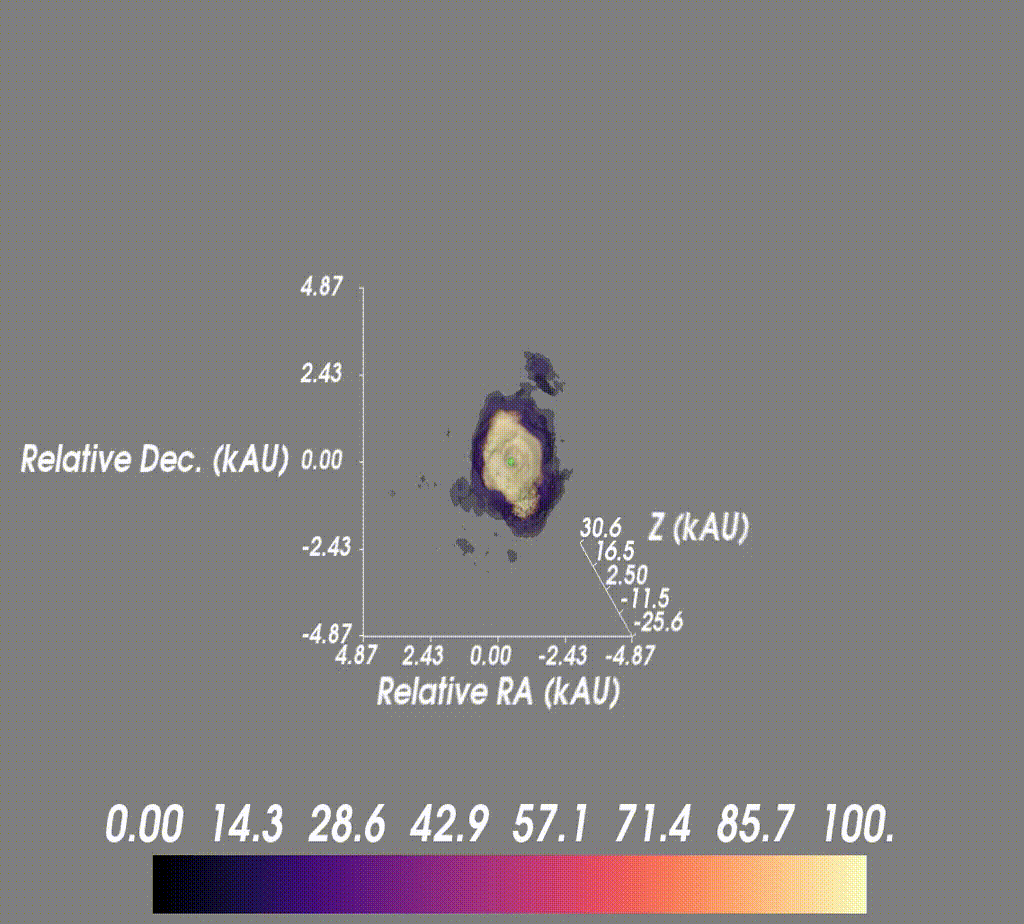News
3D rendering of the environment of a red supergiant star
An international team of astronomers led by Dr. Miguel Montargès from KU Leuven has succeeded in reconstructing the 3D geometry of the environment surrounding the red supergiant star μ Cep. The material expelled by the star during its late evolutionary stage provides the building blocks for future planetary and star forming systems. The rate at which the material is expelled is key to understand the further evolution of the star to its next stage, a supernova.
At its origin, the Universe was made of hydrogen, helium, and some traces of other light elements. Its current composition and particularly the heavier elements such as the carbon of all organic materials, the oxygen we breath, the silicon of the sand, the calcium of our bones, or the iron of our blood cells, are produced by stars, and particularly by massive stars.
 |
| 3D rendering of the environment of μ Cep in the CO J=2-1 emission line. The colors correspond to the light intensity level in units of noise. The axis corresponds to the three spatial directions in kAU (1000 astronomical units). |
μ Cep (also known as Herschel’s Garnet Star) is a red supergiant star in the Northern constellation of Cepheus. It is located at 2090 light-years for Earth. It is 15 to 20 times more massive than the Sun and is in a much later stage of evolution. During the red supergiant stage, the star expands so that if it was centred on the Sun, its surface would reach the orbit of Jupiter. Heavy elements are produced in the core of the star through nuclear fusion, transported via powerful convective motions from its interior to its surface where they are expelled to form a wind expanding outward from the star. Ultimately, after the supernova explosion, these elements will become a vital part of a new generation of planetary and star forming systems.
Using NOEMA, the team looked deep into the immediate circumstellar environment of μ Cep,
thereby opening new perspectives in the understanding of the processes that trigger the generation and evolution of winds in massive evolved stars. The astronomers observed the emission from carbon monoxide (CO) to investigate the gas motions in the stellar surroundings. The envelope of gas traced by CO around μ Cep appears to be fragmented into clouds. "This is the first time this has been possible on a red supergiant", says Miguel Montargès. Each cloud is between four and fifty times the mass of the Earth. This shows that the star loses mass in distinct clumps, which are formed at a low rate and ejected in random directions. The animation shows how the 3-dimensional motions of the wind from the star were reconstructed. The researchers concluded that there must be complex physical processes at work between the heating, cooling and mixing of the gas inside the star that trigger the stellar winds. Further investigations on stars in similar stages of evolution are now necessary to improve our understanding of the stellar wind ejection mechanism.
This project has received funding from the European Union’s Horizon 2020 research and innovation program under the Marie Sklodowska-Curie Grant agreement No. 665501 with the research Foundation Flanders (FWO) and the European Research Council (GA 646758). This work is based on observations carried out with the IRAM NOEMA Interferometer. IRAM is supported by INSU/CNRS (France), MPG (Germany) and IGN (Spain).
Contacts:
Dr. Miguel Montargès, Institute of Astronomy, KU Leuven.
Karin Zacher, public outreach officer IRAM
Illustrations: Further high quality illustrations can be obtained upon request to the author.
Further Information:
The study “NOEMA maps the CO J = 2 − 1 environment of the red supergiant μ Cep” by
M. Montargès et al. is published in the Monthly Notices of the Royal Astronomy Society. Press copies are available from the main author.

